Yarrow is an amazing edible and medicinal plant that is very common. Here is everything you need to know about foraging yarrow, a powerful plant you might have growing in your own backyard!
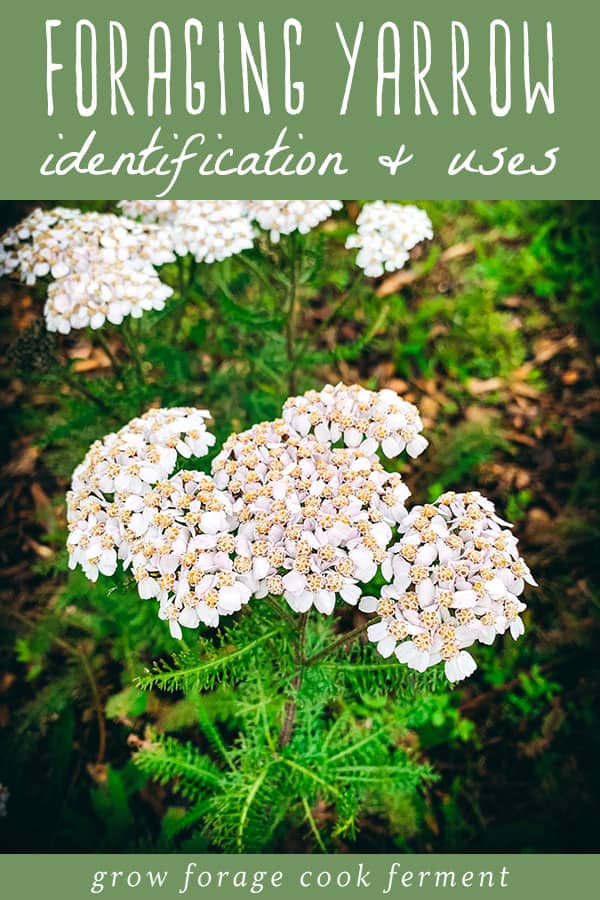
Want to save this post for later?
Wildcrafting Weeds
If you want to learn more about the edible and medicinal weeds that surround us and how to use them, check out my eBook: Wildcrafting Weeds: 20 Easy to Forage Edible and Medicinal Plants (that might be growing in your backyard)!
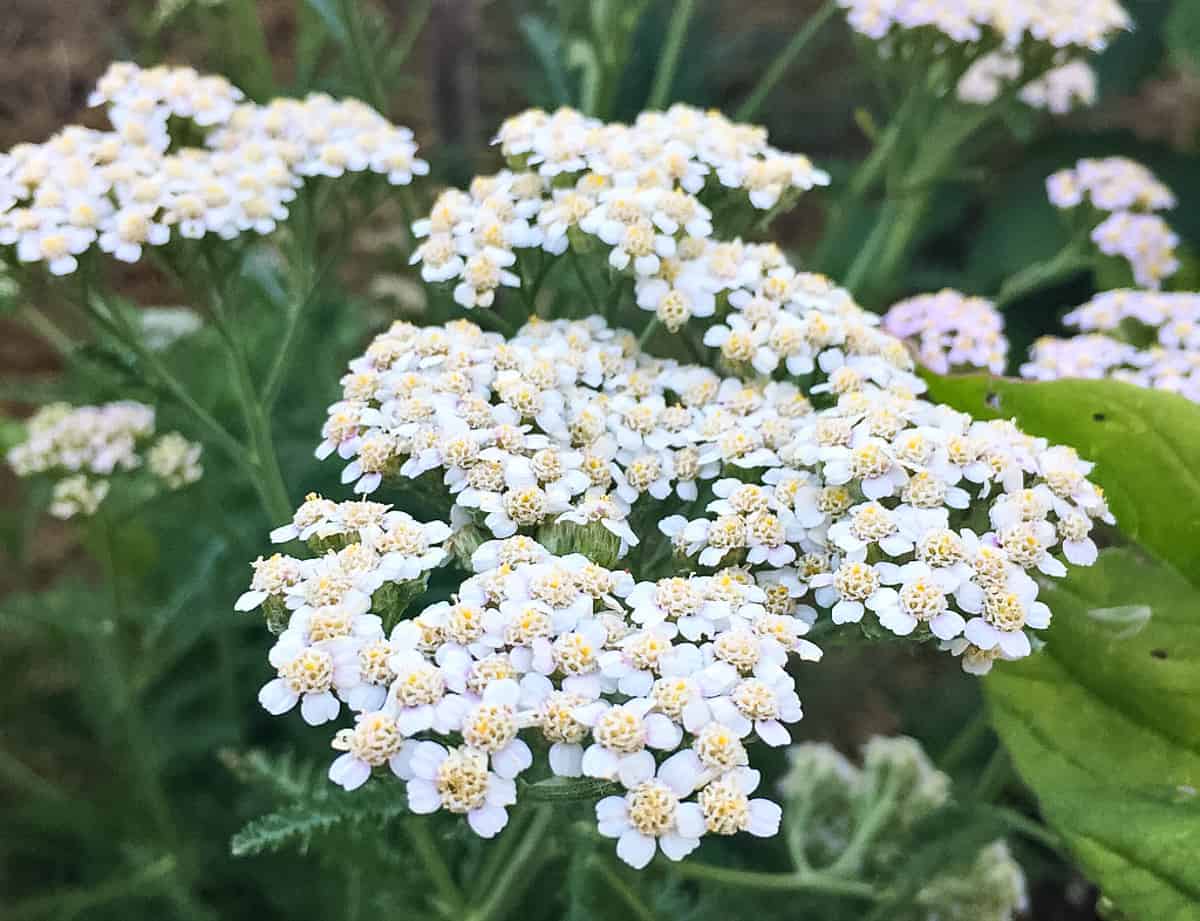
Foraging for Yarrow
Yarrow (Achillea millefolium) is a flowering perennial plant in the Asteraceae family, which is a very large family of flowering plants.
In temperate climates, yarrow grows year-round; its flowers bloom in the spring and summer and then die back. As a result, yarrow is often found without flowers during other times of the year.
The entire yarrow plant, the flowers, leaves, stems, and roots, is usable for culinary and medicinal purposes.
One thing to mention right away: Yarrow should not be used internally by pregnant women as it can potentially increase the risk of miscarriage. Using it externally on the skin is fine.
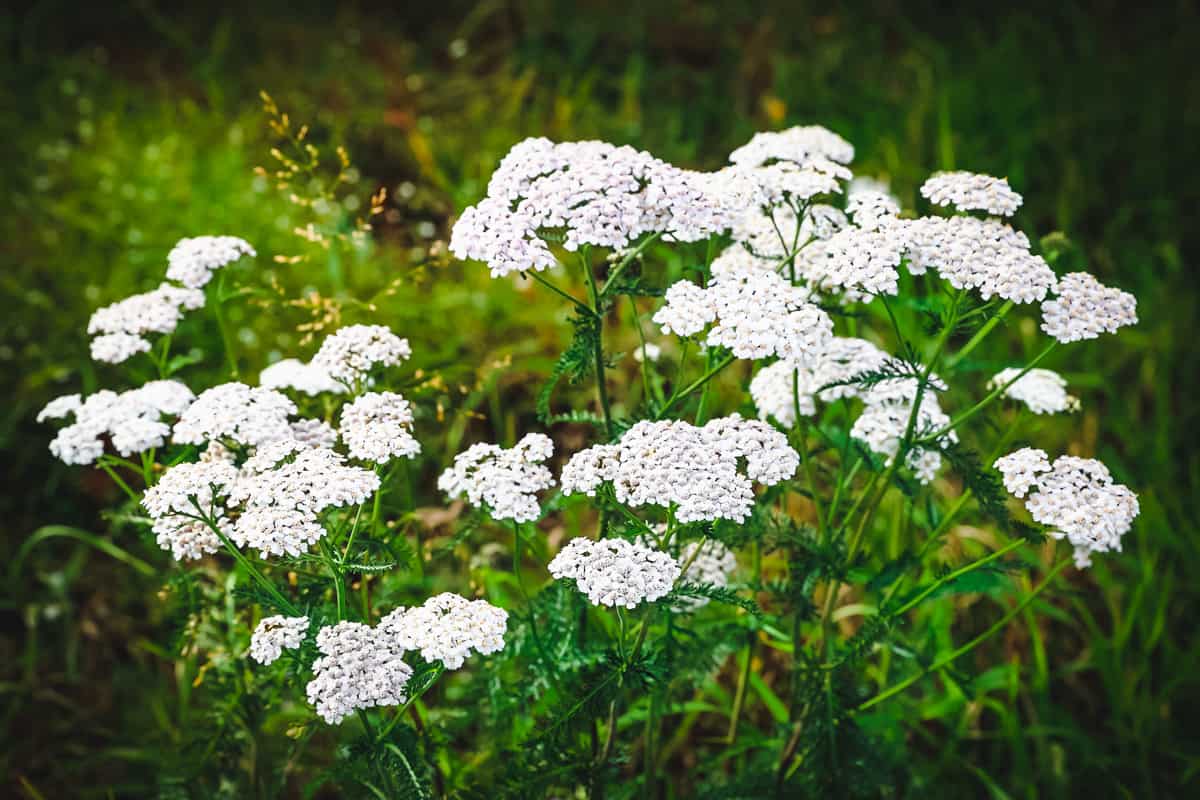
Where to Find Yarrow
Yarrow grows in temperate climates all over the world, including coastal and mountainous regions.
I’ve even found yarrow growing at 10,000 feet in the Sierra Nevada — although I did notice that the plants growing at this altitude lacked flowers.
Yarrow is commonly found growing in yards, meadows, fields, and disturbed areas.
Related: What to Forage in Spring: 20 Edible and Medicinal Plants and Fungi, 13 Early Spring Edible Wild Greens
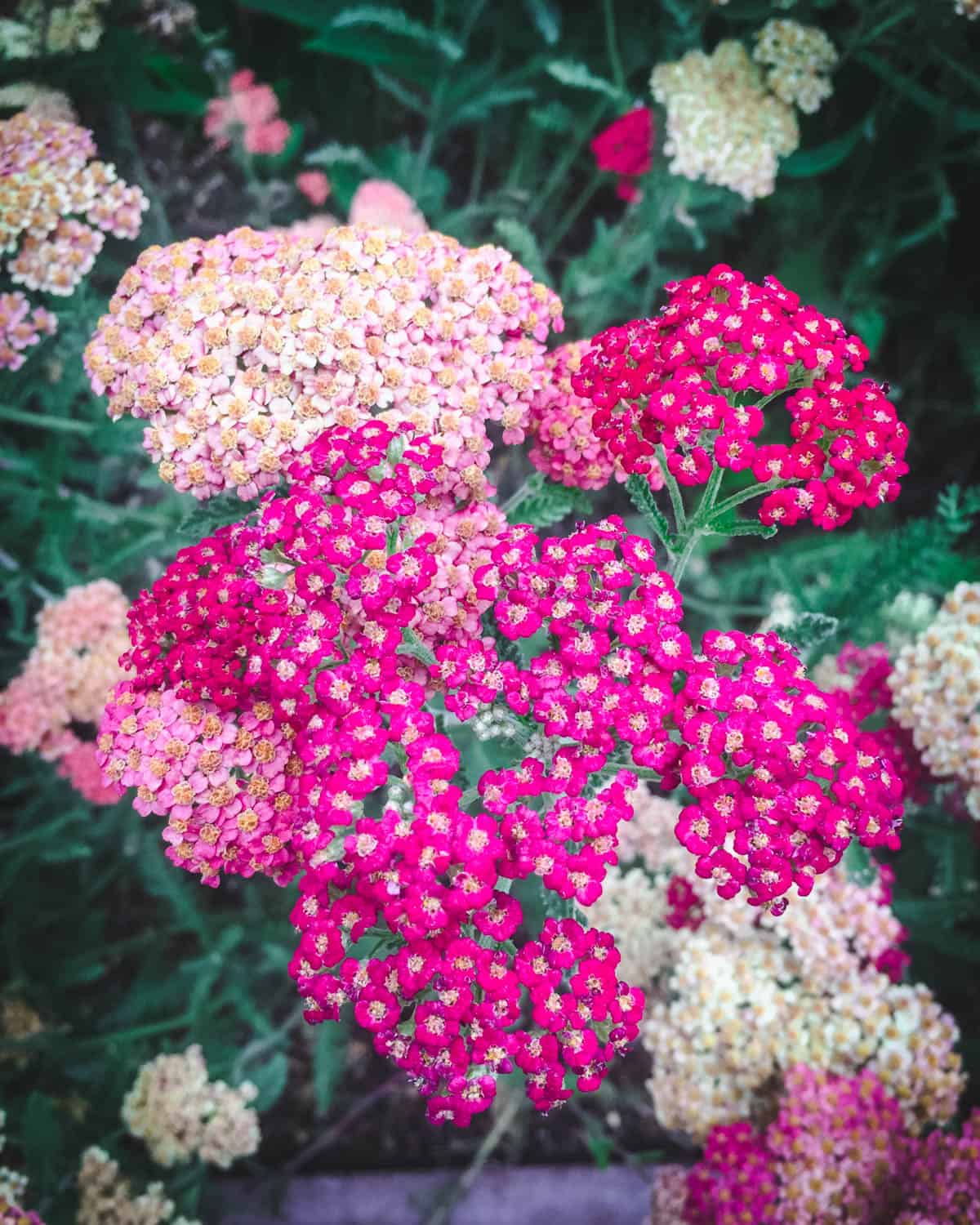
Identifying Yarrow
Yarrow is a wooly perennial plant with feather-like leaves. These frilly leaves are unique to the yarrow plant and set it apart from potential look-alikes.
Mature yarrow has a flower stalk that stands around 2-3 feet tall and ends in a tight cluster of small, daisy-like flowers. Bees love yarrow flowers and it is a great plant to include in a bee garden.
Wild yarrow typically has white or rarely pink flowers, but cultivated yarrow can have yellow, orange, pink or red flowers.
Yarrow stems are grooved and have small wooly hairs.
Yarrow smells distinctly of fresh pine needles — crushing the flowers or leaves gently in your hands will intensify the scent.
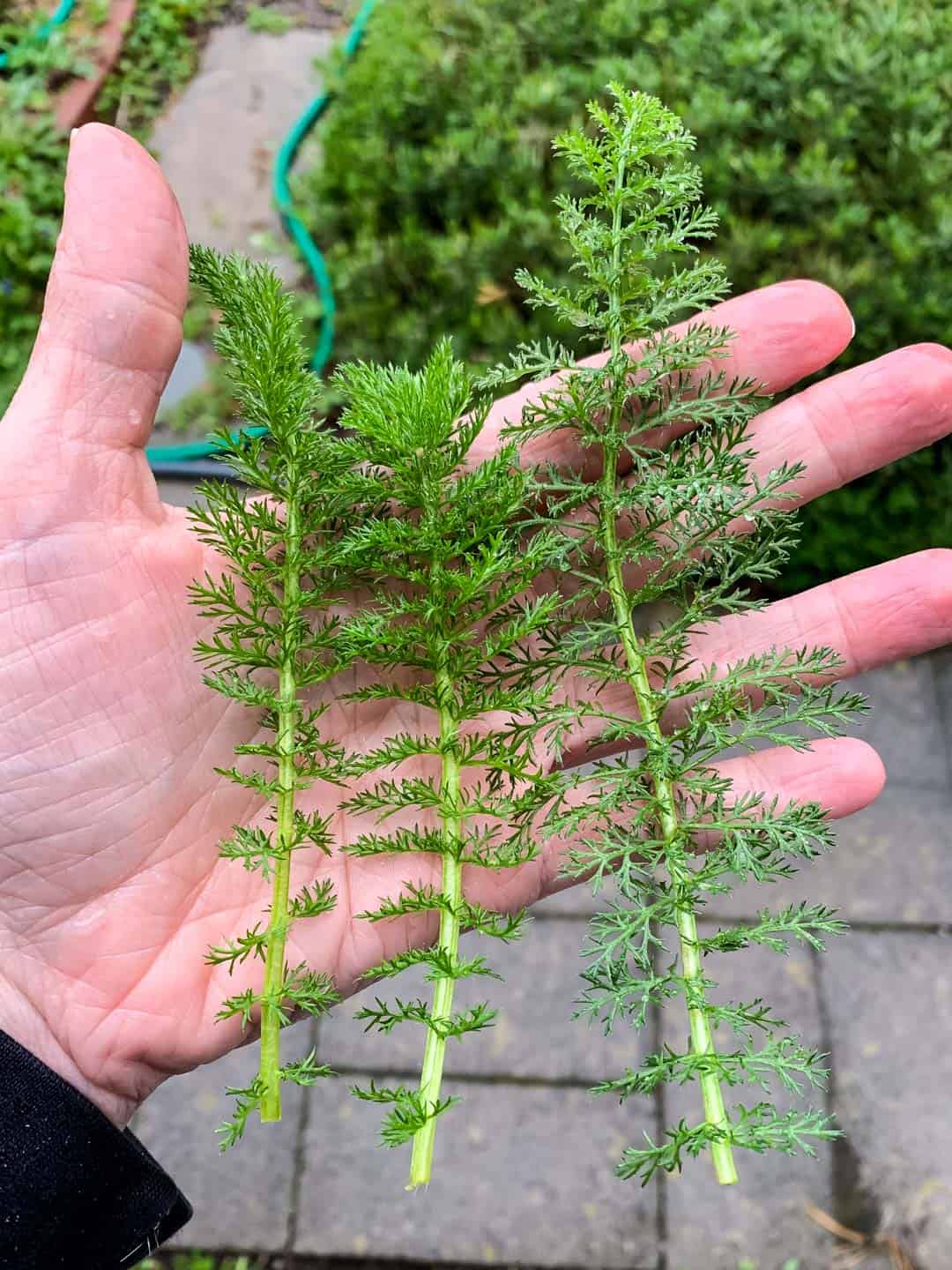
Harvesting Yarrow
Yarrow is at its most potent when it’s fresh, but it can also be dried for later use.
Hang yarrow flower stalks upside down or spread out leaves and flowers on a drying screen (you can also follow these instructions to make your own DIY drying screen) or in a basket.
Springtime is optimal for harvesting yarrow, but if you live in a warmer climate you can harvest yarrow leaves all year long.
Always remember to ask permission before you begin foraging, and make sure the plants haven’t been sprayed with poisonous chemicals.
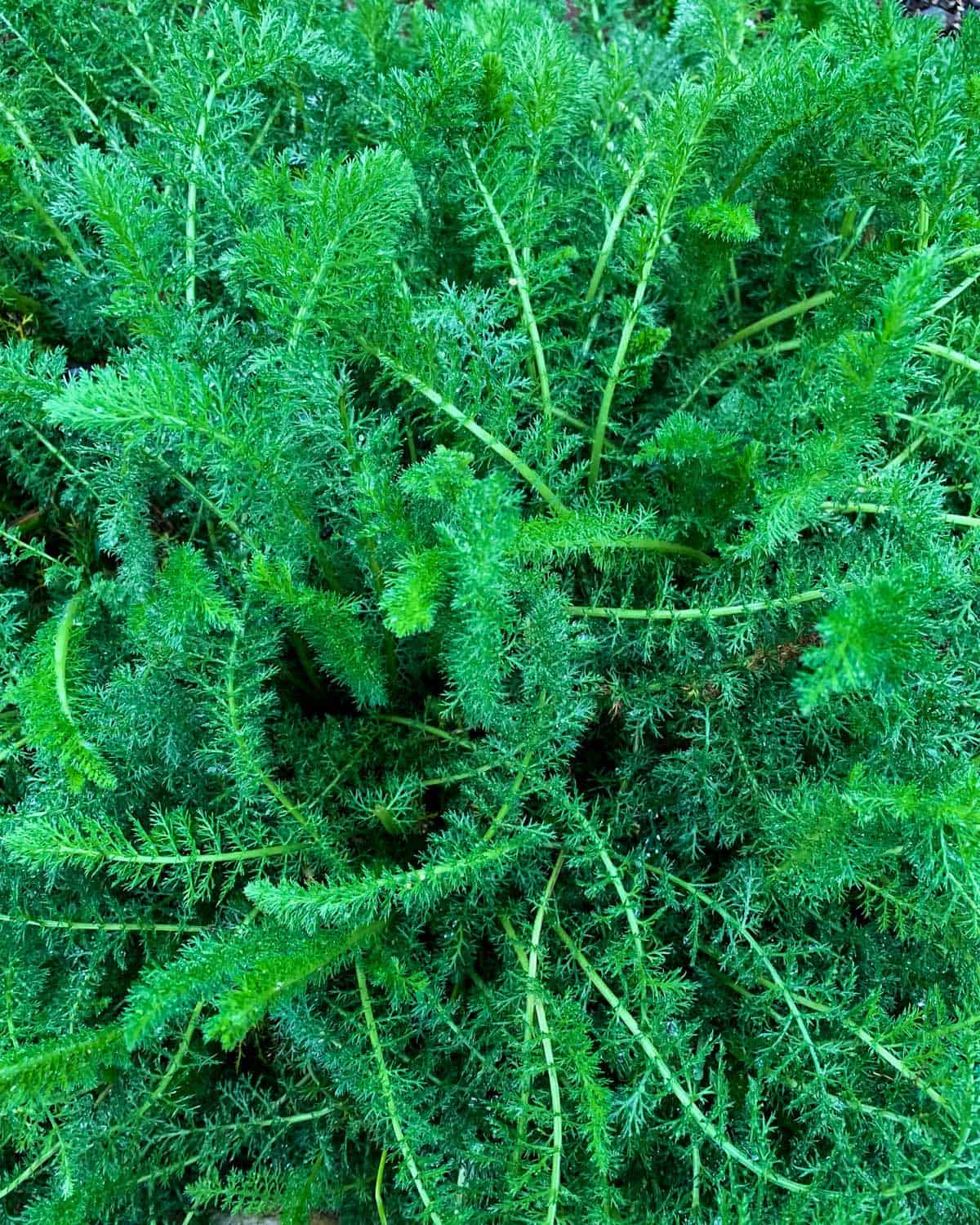
Yarrow Look-alikes
There are a few plants that are sometimes confused for yarrow.
In addition to the two more common look-alikes I’ve listed below, yarrow is less often confused for elderflower.
Queen Anne’s Lace
Yarrow is most often misidentified as Queen Anne’s lace (Daucus carota), a non-toxic plant that shares similar features with yarrow.
Unlike yarrow, Queen Anne’s lace has a true umbel-shaped flower that will often have a small dark dot in the center, a hairy stem (“the Queen has hairy legs”), and a distinctive carrot scent.
Queen Anne’s lace is actually wild carrot and has edible and medicinal uses.
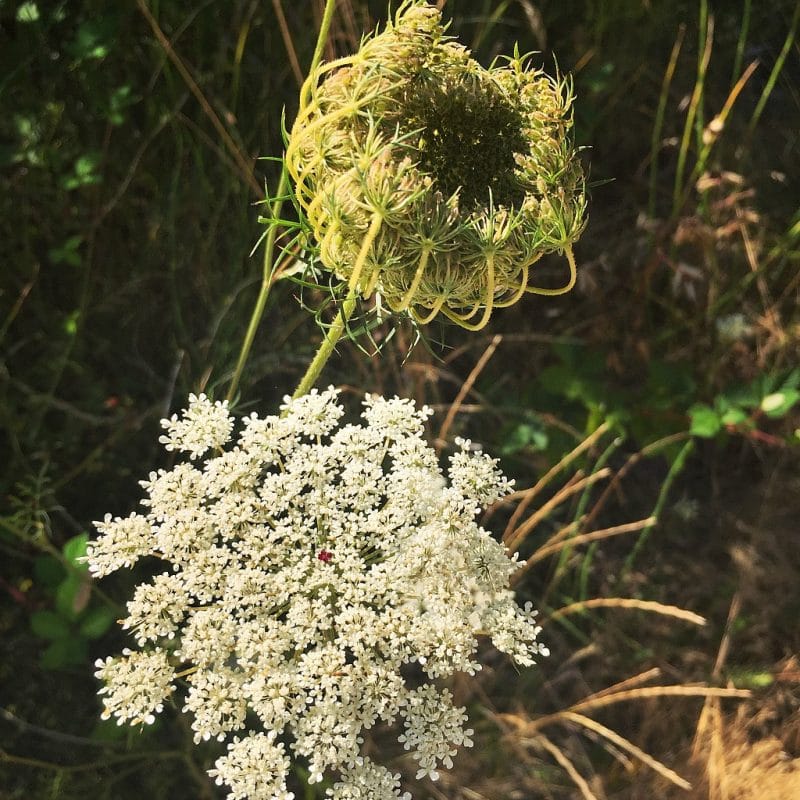
Poison Hemlock (highly toxic!)
The other plant that is sometimes mistaken for yarrow is poison hemlock (Conium maculatum), which is absolutely very toxic!
To the trained eye, the physical differences between yarrow and poison hemlock are obvious, so make sure you check out my in-depth guide to poison hemlock.
It includes detailed instructions for identifying (and avoiding) this very poisonous plant.
Mature poison hemlock plants are 3-4 times larger than yarrow and the stem is covered with purple spots.
Younger poison hemlock plants are slightly more similar in appearance but again, are recognizable once you know what to look for.
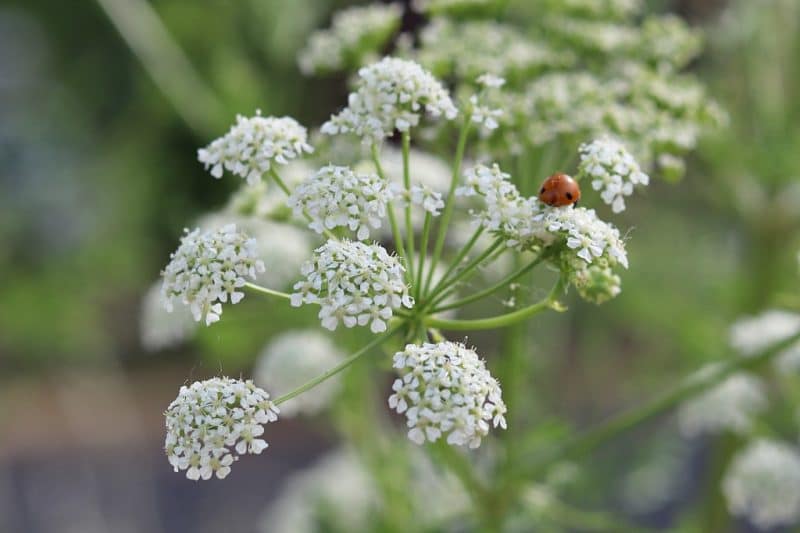
Edible Uses of Yarrow
Yarrow has a strong bitter flavor and should be used judiciously, but it is edible!
When you’re foraging for yarrow look for young leaves, they’ll be slightly less bitter.
Cut young yarrow leaves into a fine chiffonade, adding a sweeter fresh herb into the mix to counter the bitterness.
In this recipe for Penne Aglio Olio with Yarrow, yarrow leaves are combined with equally assertive ingredients such as dried chilies, anchovy, and parmesan cheese.
If you’re into homebrewing, you may have tried using yarrow flowers in place of hops. Like hops, yarrow flowers lend a distinctly bitter flavor to traditionally hoppy beers.
I especially like to add yarrow flowers to homebrew, such as this Honey Lemon Yarrow Summer Beer.
You can also check out my post on How to Make Wildflower Mead, which calls for yarrow flowers.
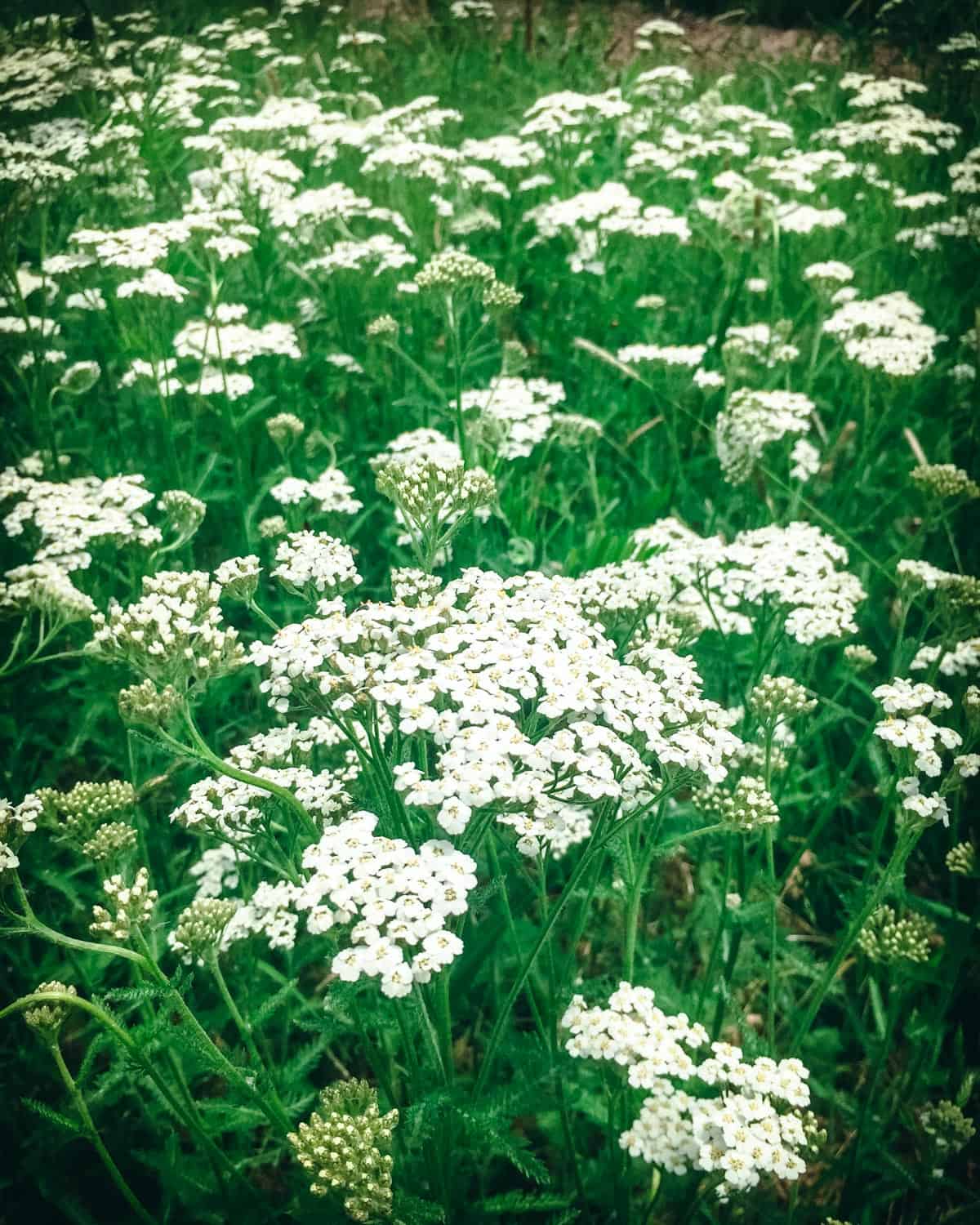
Medicinal Uses of Yarrow
When it comes to foraging for plants with medicinal uses, yarrow is one of the most important to be aware of.
Yarrow has antiseptic, astringent, antimicrobial, and anti-inflammatory properties, making it a useful herb to have on hand for a wide range of ailments.
Yarrow leaves can be used as poultice or ground up into a styptic powder to help stop bleeding. The styptic powder, which is made from dried and ground yarrow leaves, should be applied directly onto the bleeding wound.
Yarrow is so effective at coagulating blood, it has historically been used on the battlefield to stop bleeding during times of war.
Yarrow improves circulation and is great for the reproductive system as it balances women’s monthly cycles and regulates menstruation. It is also good for the digestive system.
You can also use yarrow to make an herbal salve that will help to heal minor cuts and wounds. Try this yarrow salve recipe which is also great for dry skin.
Yarrow is also known for its ability to help regulate body temperature due to fever.
Sipping on a cup of yarrow tea will give you relief, as will taking a yarrow leaf bath. This is a great way to lower a temperature in an infant or toddler.
Yarrow tea is a fairly powerful diuretic, which means it can be ingested medicinally to combat urinary tract infections.
Because yarrow tea is so bitter, a concentrated homemade tincture might be a more appealing way to consume yarrow.
Yarrow is one of the herbs included the UTI Tea, Fever Tea, and Four Herb Wound Salve recipes in my book Healing Herbal Infusions.
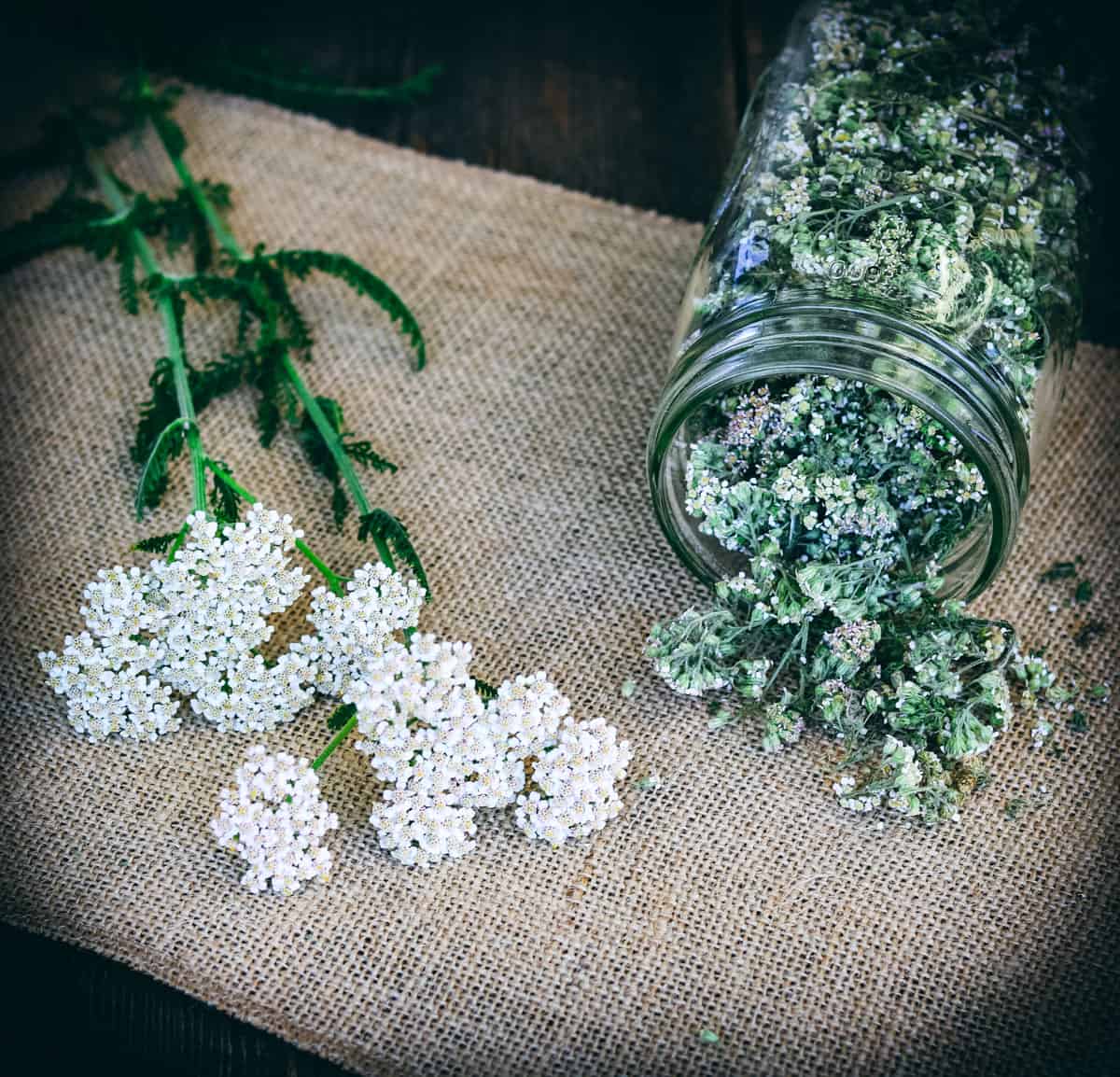
Using Yarrow for Skin Care
Yarrow is also a great choice for skin care as it is astringent and soothing for the skin.
When I’m fortunate enough to be flush with both yarrow and wild rose, I make this Wild Rose and Yarrow Soap to give away as a stress-relieving gift throughout the year.
This Yarrow and Witch Hazel Soap sounds wonderful as well.
For very dry skin and cracked heels try this hydrating Plantain and Yarrow Dry Heel Balm.
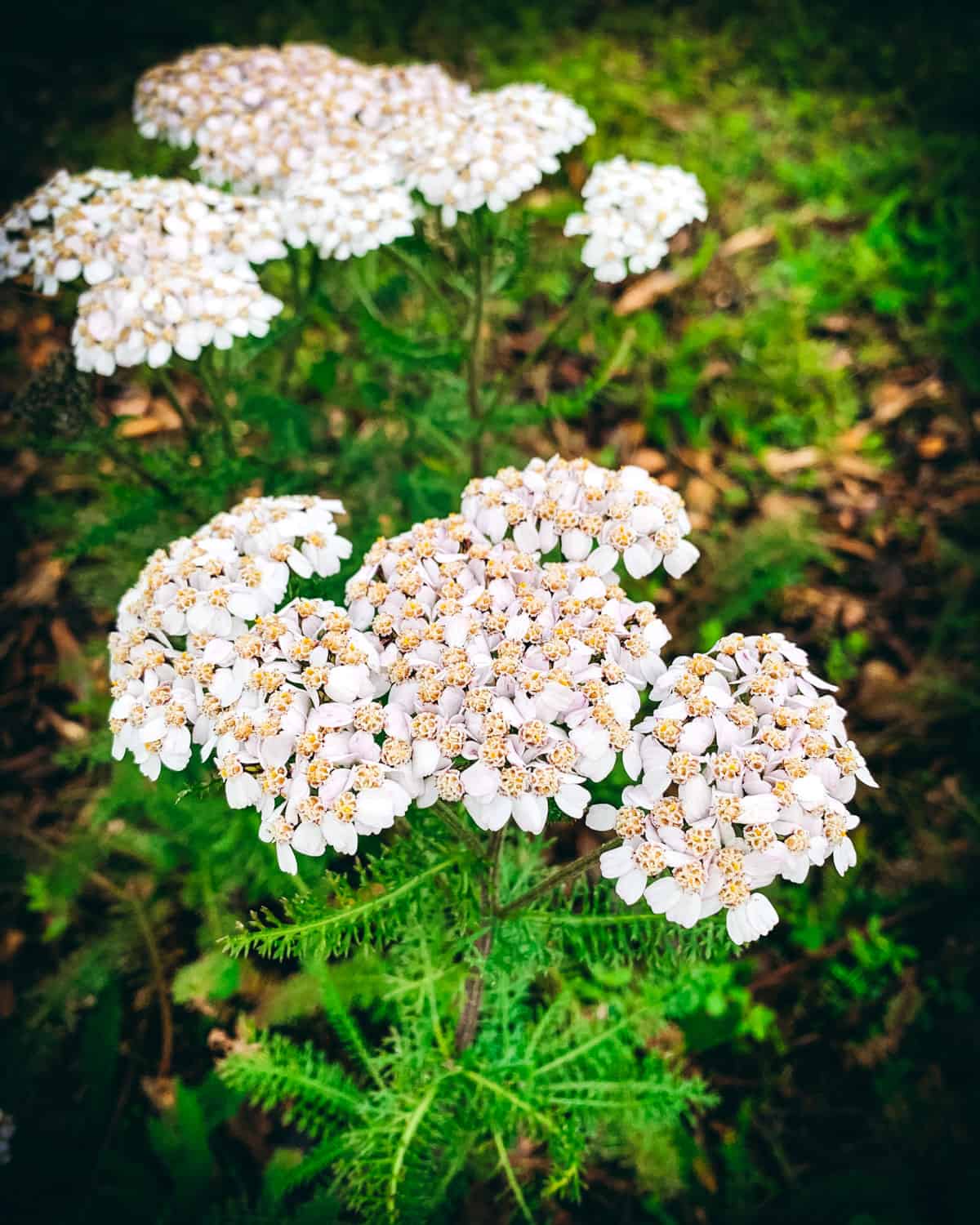
It almost seems like there is nothing that yarrow can’t do!
You should definitely try foraging for yarrow in the spring and summer. I’m almost certain that you will find some!
If for some reason you can’t find any, or if it’s the wrong time of year for foraging, you can always purchase dried yarrow from Mountain Rose Herbs.
Happy yarrow foraging!

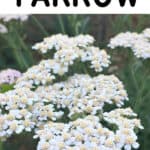
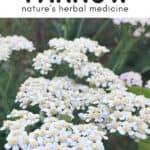
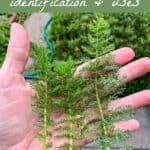
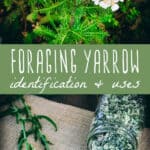

Forgive me if this has been asked and answered…
How do I harvest it properly so that the plant continues to grow? Cut the flowers? Cut the leaves? Cut it at the stem?
I do realize yanking it up by the roots will remove it from our pasture. Which I DO not want to do.
As long as you only harvest the first couple inches below the flower, it will continue to grow. For the leaves, I usually only take one or two from each plant.
I love Queen Anne’s lace. It grows every where on or farm. One way I identify Queen Anne’s lace, is in the middle of the umbrells there is a small magenta staymin. I’ve dried the seeds, which work great if your having stomach problems. The ground seeds make a wonderful seasoning, that tastes like Coriander.
I really need this for several ailments, but I haven’t seen it grow anywhere in my city. I ordered some seeds, but they sprouted and then died. I’m not sure exactly why. Any suggestions for how to grow it from seed successfully? I’d really appreciate any advice you might share. Thank you either way.
Check out MorningsunHerbFarm.com. The sell and ship small herb plants and they sell the white yarrow. I would not bother with growing from seed unless you have a greenhouse to start them in, which is what I do. Although, I have not started Yarrow form seed since Morningsun Herb Farm is one block from my house, I bought a yarrow plant from them. Note, it is a VERY aggressive plat will spread.
I’m growing some tape this year, but it is a mix of colors. Can they all be used the same? I’m really struggling to find any definitive information on the subject.
Hey I have also found on hikes that rubbing the yarrow leaves between my fingers and taking in the smell has helped with congestion. I always try to keep some in my pocket during allergy season.
Do the leaves on the ground surrounding the stalks have the same medicinal properties as the leaves attached to the stem?
Hi Cathy. I’m not sure I understand what you mean. Do you mean leaves on the ground that have fallen off the plant?
Achillea millefolium, Yarrow removes cysts on the ovaries.
Thanks
I think I found some out in the field but we had a couple of hard frost and the flowers are brown. The plants are about 18 inches high and the leaves are fern like and the stems are slightly fuzzy . Is there any way to positively identify them this time of year or wait until spring ?
Hi Brian. I can’t identify your plant based on your description alone. It might be best for you to wait until spring.
I use yarrow in my husband blood pressure medicine I make for him. I also have tons growing in my yard and I have moved it to a container now I have it when I need it.
I would love to have the recipe you use to make your husband’s blood pressure medicine.
I need it also big time please thank you
Hi! I LOVE your website and reference it often :) Can you tell me if both the leaves and flowers can be used for fever? Thanks!
Hi Amber,
Both flowers and leaves can be used for fever. All above ground parts are used for medicine. I hope that helps!
JoAnn
what are your thoughts about cultivated Yarrow? I have some in the yard that has a pink flower. can it be used medicinally? I have heard different things.
Love it i have planted it before but the flowers are yellow.
Hi, I read that only the white and pink varieties of yarrow should be taken internally, but that the yellow variety should not. They didn’t say why exactly. Is there anything you have heard about this?
I think you should at least mention poison hemlock as a deadly look-alike! They could be confused to introductory students like myself. Looks like poison hemlock has thicker leaves and a smooth stalk, queen anne’s lace has a tiny purple flower in the middle of the white ones and a hairy stalk, and yarrow has more delicate leaves with a medium-ly hairy stalk.
Thank you for the blog! Very interesting and helpful!!
You’re right, I will update the post with that info. I also have a post all about poison hemlock here. Thanks!
I actually came here from the Hemlock page, found a plant growing outside and was rather concerned that I couldn’t positively identify it, all I knew was that it definitely wasn’t Queen Anne’s Lace but it didn’t quite identify as Poison Hemlock either.
Looking at the pictures up above the “when it first flowers” shot is pretty much identical to what I found.
I’d always seen Yarrow with colored flowers and wasn’t aware that it also came in white, plus I’d always seen lower plants with the leaves bunched together that didn’t have clearly visible stalks, so the white umbral flower (with no tell-tale purple flower in the center) and hairless (but also splotchless) stalk was a complete mystery to me.
Looks something like queen anne lace but different flower. Is it related?
They do look similar, but it is a totally different plant.
Hi There
I have recently found your website and am so excited. I have been foraging, making tinctures and teas for a couple of years now but still consider myself a novice at it. I was never really quite certain that the suspected yarrow on my property was indeed yarrow but it looks identical to The pics you poster. I cut apiece of it and noticed it has a hint of an evergreen scent. So, my question would be when you harvest your yarrow did you detect The same smell? If so I would then feel comfortable in harvesting yarrow on my property. I’m so appreciative that I can have someone with knowledge I can go to with this question. Many thanks to you for your help.
Suzanne
Yes, yarrow does have a slight evergreen scent! Sounds like that’s what you have :)
I’d like to grow some yarrow – can plants be bought for it? Does it grow back every year or do we replant? Someone gave me a handful to dry and play with. I thought I’d make up a salve or something with it but only have about 1/4 -1/3 cup. So I need more lol
I have acquired some yarrow and have it in my garden. It is in it’s second year and is quite productive. I am so grateful for this, because my pug has acquired allergies and the yarrow tea has seemed to soothe my little itchy bitchy!
Ohh I have 2 pugs too! Thank you for posting your comment!
Regarding slow cookers l find if you leave the lid of it douse not get mas hot l use this method when caramelising onions
Enjoy reading your posts. When I found yarrow coming up in my garden I was soooo delighted. It give such a delightful show when in bloom and the feathery leaves give a wonderful texture to the garden. I use the spent flowers of it and other plants for a lovely winter arrangement. Will try the tea
Steep yarrow in boiling water, strain and cool the water down to room temp. Use as a rinse for your hair and faxce. Lovely shine!
Is yarrow also so known as rag weed?
Nope, different plant!
I have both wild and culitvated plants. Are the wild ones better for herbal uses?
I would think that they both have medicinal value, but the wild one may have a little more :)
When I was a young girl growing up in a remote area no stores or electricity , I cut my palm quite deep,bout 2 inches, lots of bleeding ,my father ran down to the beach to get yarrow, after masicating it he put it over my cut n bandaged it, I was completely grossed out by this but it worked ,for such a deep cut I was surprised it barely left a scar. . .
Ditidaht Rose
Love your story! Your father must have come up with that to get your mind off your pain. 😁 Smart man! I’m sure I would have been grossed out if my dad had walked towards me with chewed up yarrow to put on my wound. But father knows best! ❤
Actually, mastication is one way, in an emergency, to quickly activate the medicinal compound, i.e. make them available to do their work. I’ve also heard of this method for using plantain in survival situations. A mortar and pestle would probably be more hygenic, but mastication is still a very good way break down those cell walls and get all those great medicinal compounds free and flowing to do their “magic” :-)
I have looked for the wild yarrow but so far haven’t been able to find it. I could just be completely overlooking it but now that you’ve shown the leaves up close, I’ll know exactly what to look for.
Thanks for all you share!
Hi! I have yarrow growing instead of grass. I’ve recently harvested, dried and infused a bunch in my crockpot in coconut oil but it might be overcooked as the yarrow was crispy when I turned it off after 5 hours on low. Can I still use the oil?
I love that you have a yarrow “lawn”! You can probably still use the oil as long as it doesn’t smell burnt, but it may not be the best quality oil. Making infused oils in the slow cooker can be tricky, as many of the newer ones tend to get too hot even on the low setting, and so need to be watched carefully.
I’ve had the best results using the warm setting on my Crockpot. If I’m remembering correctly, it hits about 165 degrees Fahrenheit on mine, perfect for keeping it from burning off much of the volatiles in most herbs.
try using the “keep warm” setting.
I have it in my yard, too. Do I use it “fresh” or dry it. You showed a jar of it, how does it keep.
Hi Colleen, great website chalked full of lots of info on foraging. I began foraging about 3 yrs ago. You are ambitious to do it during winter!:) I haven’t seen that type of yarrow either with the fern-like leaves. I’m more familiar with the broader leaf and larger/dense flower heads.
Thanks, so glad you like my site! Foraging in winter is pretty easy where I live as we don’t get very much harsh weather, thankfully! The yarrow I show here is just regular wild yarrow, but it’s still young. It will get the broader leaves and bigger flowers like you speak of once it gets bigger.
I haven’t seen yarrow like that. I’ve always heard that it looks more like Queen Anne’s Lace—tall, with a wide head of flowers in white ot yellow.
Yes, that is exactly what it looks like once it’s fully flowered. These pictures were taken in winter/early spring so it had only just begun flowering so it was still pretty small.
That sounds more like valerian.
I wasn’t sure about yarrow for tea but you’ve convinced me. I have tons of it growing in my backyard. Thanks for the idea!